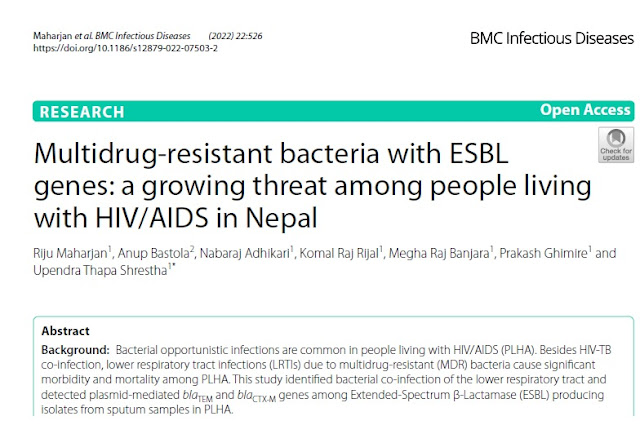- Environmental sanitation
- Personal hygiene -regular hand washing
- Avoid unknown sources of drinking water and street foods
- Reasonable hygiene; use of disposable plates/glasses as much as possible for food serving, washing of food utensils with 0.5% hypochlorite water
- Proper sewage disposal
- Avoid raw vegetables
- Use boiled or chlorinated water for drinking
Tuesday, June 28, 2022
Cholera cases in Kathmandu - How to prevent yourself???
Friday, June 10, 2022
Multidrug-resistant bacteria with ESBL genes: A growing threat among people living with HIV/AIDS in Nepal
Multidrug-resistant bacteria with ESBL genes: A growing threat among people living with HIV/AIDS in Nepal
Riju Maharjan1, Anup Bastola2, Nabaraj Adhikari1,
Komal Raj Rijal1, Megha Raj Banjara1, Prakash Ghimire1
Upendra Thapa Shrestha1*
1 Central Department of Microbiology, Tribhuvan
University, Kirtipur, Kathmandu, Nepal
2 Sukraraj
Tropical and Infectious Disease Hospital, Teku, Kathmandu, Nepal
*Corresponding author: Upendra Thapa Shrestha, Central
Department of Microbiology, Tribhuvan University, Kathmandu, Nepal, Email: upendrats@gmail.com / upendra.thapashrestha@cdmi.tu.edu.np
ABSTRACT
Background:
Bacterial opportunistic infections are common in people living with HIV/AIDS
(PLHA). Besides HIV-TB co-infection, lower respiratory tract infections (LRTIs)
due to multidrug-resistant (MDR) bacteria cause significant morbidity and
mortality among PLHA. This study identified bacterial co-infection of the lower
respiratory tract and detected plasmid-mediated blaTEM and blaCTX-M
genes among Extended-Spectrum b-Lactamase
(ESBL) producing isolates from sputum samples in PLHA.
Methods:
A total of 263 PLHA with LRTIs were enrolled in this study, out of which, 50
were smokers, 70 had previous pulmonary tuberculosis, and 21 had CD4 count
<200 cells/µl. Sputum samples collected from PLHA were processed with
standard microbiological methods to identify the possible bacterial pathogens.
The identified bacterial isolates were assessed for antibiotic susceptibility pattern
using modified Kirby Bauer disk diffusion method following Clinical Laboratory
Standard Institute (CLSI) guidelines. In addition, plasmid DNA was extracted
from MDR and ESBL producers for screening of ESBL genes; blaCTX-M and blaTEM
by conventional PCR method using specific primers.
Results:
Of 263 sputum samples, 67 (25.48%) showed bacterial growth. Among different
bacterial pathogens, Klebsiella
pneumoniae, (17; 25.37%) was
the most predominant, followed by Haemophillus influenzae, (14; 20.90%) and Escherichia
coli, (12; 17.91%). A higher infection rate (4/8; 50%) was observed among
people aged 61 -70 years, whereas no infection was observed below 20 years.
About 30.0% (15/50) of smokers, 32.86% (23/70) cases with previous pulmonary
tuberculosis, and 52.38% (11/21) with CD4 count <200 cells/µl had bacterial LRTIs.
Among 53 bacterial isolates excluding H. influenzae, 28 isolates were MDR
and 23 were ESBL producers. All ESBL producers were sensitive to colistin and polymyxin
B. Among ESBL producers, 47.83% (11/23) possessed blaCTX-M, 8.6% (2/23) were positive for blaTEM gene, and 43.48% (10/23)
possessed both ESBL genes.
Conclusion:
The increasing rate of MDR bacterial infections, mainly ESBL producers of LRTIs
causes difficulty in disease management, leading to high morbidity and
mortality of PLHA. Hence, it is crucial to know the antibiogram pattern of the
isolates to recommend effective antimicrobial therapy to treat LRTIs in PLHA.
Keywords: PLHA, Lower respiratory tract infection, ESBL, blaCTX-M, blaTEM
Bacteria in Photos























